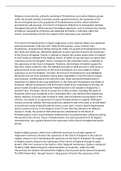Religious nonconformity, primarily consisting of Presbyterians and radical religious groups
under the broader bracket of puritans, posed a genuine threat to the supremacy of the
Church of England due to the popularity of Presbyterianism and the radical intentions
promoted by radical groups. The Church of England is defined by its episcopalian ideology
throughout the period. While narrower theological arguments, such as between the 'beauty
of holiness' espoused by Arminians and supported by Charles I, took place within the
church, not presenting a threat, the support of the episcopacy was consistent.
The threat of Presbyterianism to replace anglicanism as the national religion was significant,
particularly between 1638 and 1649. While 80,000 puritans, many of whom were
Presbyterian, emigrated from Britain during the 1630s, the growth of Presbyterianism in the
late 1630s and 1640s was sufficiently significant to pose a genuine threat to the supremacy
of the Church of England. Charles I's attempt to impose the Laudian prayer book in Scotland
in 1637 marks an attempt of the Anglican church, of which he was the head, to impose their
supremacy across the Kingdom. Hence, resistance to this imposition marks a challenge to
the supremacy of the Church of England. Therefore, the fortitude of Scottish support for
their Kirk, which resulted in riots, the National Covenant of 1638 and war in 1639 shows a
genuine threat to the supremacy of the Church of England, as it was unable to enforce
supremacy across the Kingdom. Secondly, the threat of Presbyterianism was highlighted
during the civil war by its popularity during peace negotiations. From the Solemn League
and Covenant, orchestrated by Pym with the Scots, which promised Presbyterianism's
imposition in England by the Long parliament, to the Newcastle Propositions and Heads of
Proposals, offered by parliament and by the New Model Army respectively to the King, all
peace treaties included a provision for Presbyterianism to be imposed in England for a
period of time. The King's refusal to accept any of these treaties, including the Heads of
Proposals, which was considered to be a reasonable offer, may diminish this Presbyterian
threat. However, his treaty with Scotland in 1648, which started the second phase of the
civil war, was based on an agreement to impose Presbyterianism in England. Although it
remains uncertain whether the King would have upheld his side of the deal, as he had failed
to do with the treaty of Berwick with the Scots in June 1639, it seems that Presbyterianism
posed a serious menace to the Anglican church if even the King claimed to be willing to
impose it. Finally, the period of 1645-48 shows the embodiment of the threat of
Presbyterianism as the Long Parliament implemented it via parliamentary ordinances during
this period of the civil war. Hence, Presbyterianism, the most prevalent form of religious
nonconformity, was a geuine threat to the supremacy of the Church of England during the
period.
Radical religious groups, while never sufficiently numerous to overtake support of
Anglicanism and hence threaten the supremacy of the Church of England as the national
religion, played a role in threatening the supremacy of the Church of England. The support
of Quakers posed a threat to the supremacy of the Church of England through its rapid
growth. After Fox's mission to the South in 1654, taking 60 missionaries, Quakers numbered
35,000 in 1660. While lacking the radical intentions of revolution, unlike the Fifth
Monarchists, the Quakers threatened the Anglican Church purely by the speed of its growth.
The Fifth Monarchists, through Venner's rising posed a threat to the supremacy of the




